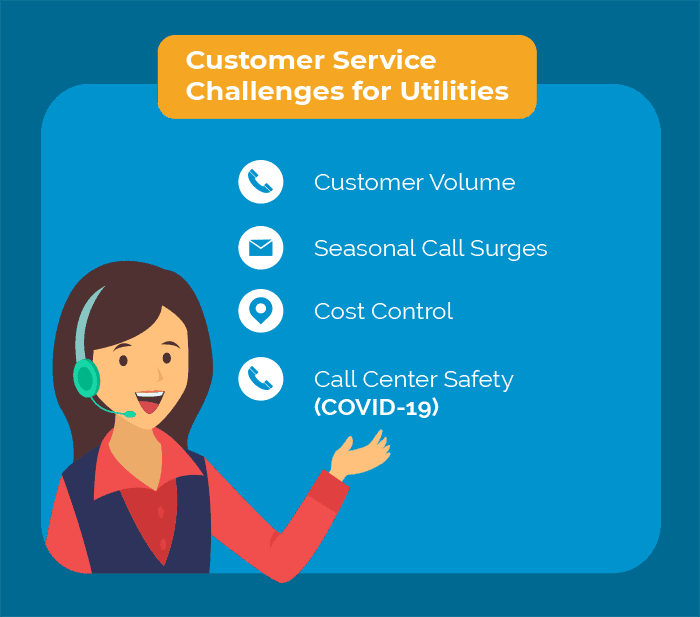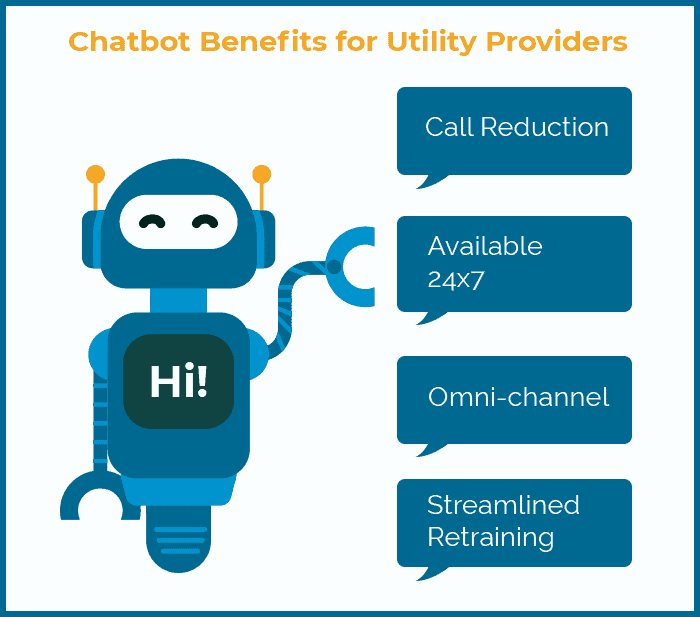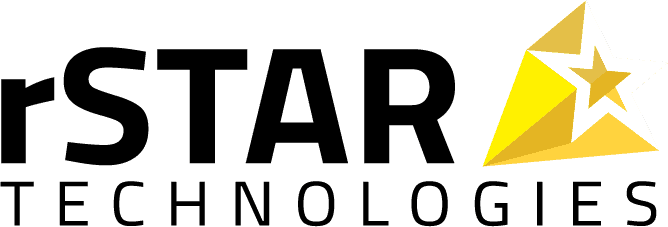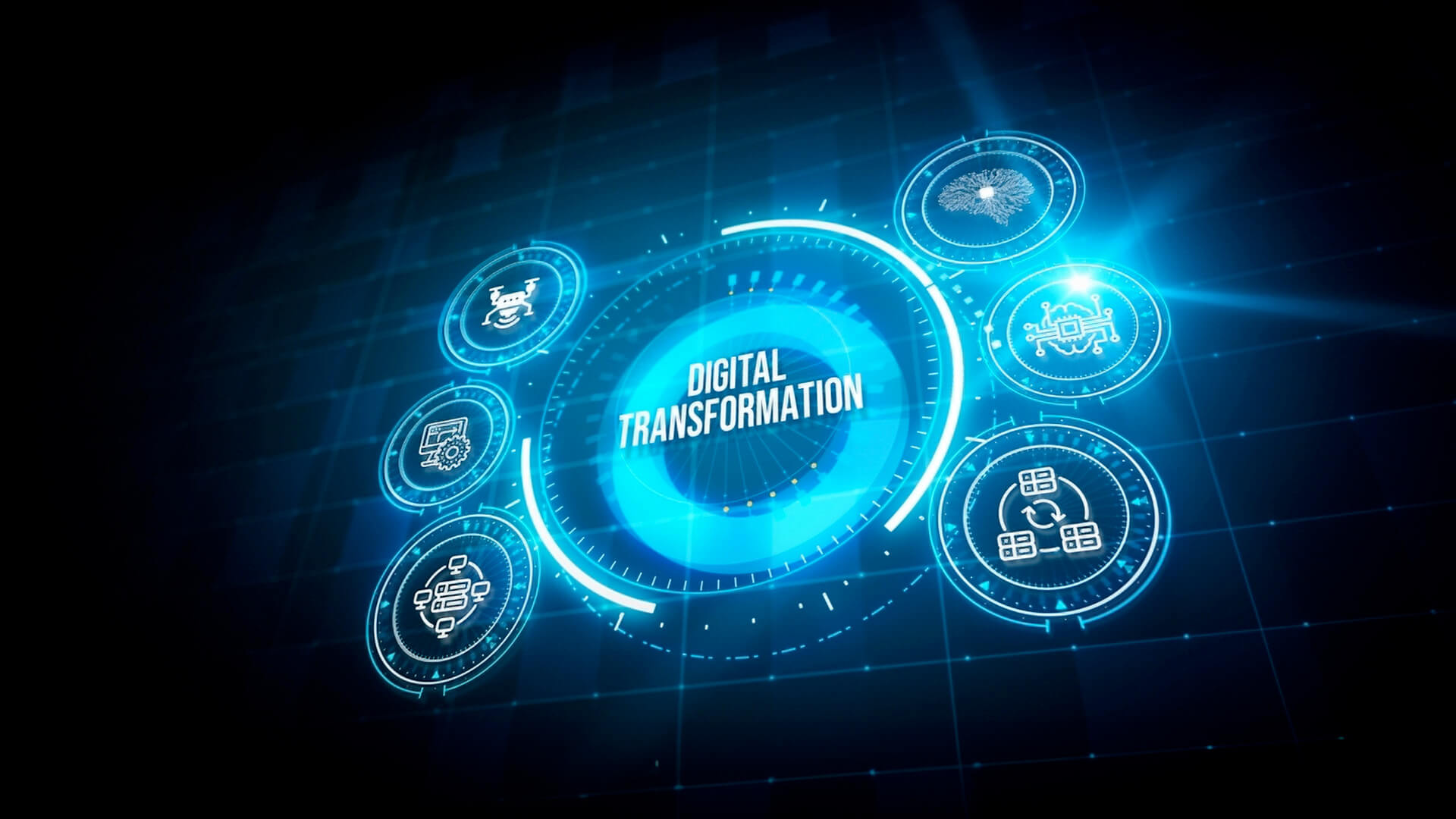Chatbots powered by artificial intelligence and machine learning can help utilities improve their bottom line by elevating the customer experience and customer satisfaction to new heights while reducing the related operating costs.
Table of Contents
Looking ahead, we’ll explore…
- Why customer service is especially relevant for utilities
- The biggest customer service challenges facing utility companies
- How chatbots address these challenges by improving the customer experience while reducing the related support costs
- How utility companies can start a conversation about revolutionizing customer support via chatbots
Why Customer Service is a Top Investment Priority for Utilities
At the end of the day, public and private utilities are service-oriented businesses. That means treating customers well and being responsive to their needs is just as important as the flow of water, electricity, natural gas, wastewater or internet service.
Customers don’t want to call support hotlines; they do it because they need to. They need to start or cancel services, report an outage, pay their bills, and so on. Making those processes easy is the difference between satisfied, happy customers creating a positive buzz in the community or on social media and frustrated clients looking to change service providers.
Given the current climate of deregulation, it’s also conceivable that competition between utilities will increase even more in the coming years. In that scenario, faster, more satisfying customer service will absolutely be a key distinguisher that sets the most attractive, customer-friendly utilities apart from the rest.
Top Utility Customer Service Challenges in 2022
Some of the customer service challenges in the world of utilities are timeless: infrastructure maintenance, timely billing, and so on; but the current climate of increased tech literacy and expectations of expedient service among consumers is creating both new opportunities and new responsibilities.
Let’s take a look at the primary service challenges facing public and private utilities today:

Customer Volume
Public and private utilities can be responsible for millions of individual customers. Every single one of those customers expects straightforward access to satisfying service.
Seasonal Call Surges
Ice storms, frozen pipes, hurricanes, and other calamities create massive, but semi-predictable, increases in service calls. Ensuring every customer is supported in a timely manner during their time of need is essential to good business.
Cost Control
All of the above challenges need to be managed and navigated in a way that’s mindful of the need to manage costs. As utilities improve the quality and accessibility of their customer service frameworks, they must also find ways to stay as lean as possible while still providing the best possible experience for the customer.
New COVID-19 Realities
Utility companies have long relied on traditional call centers to meet customer service needs. Now, those centralized, human-intensive operations may no longer be a best practice, and support professionals must be protected without sacrificing quality of service.
Why Chatbots are Perfect for Utility Challenges
Chatbots, sometimes known as “conversational agents,” are text- and voice-based interfaces that provide support and connect human users with the service or information they need by simulating a traditional person-to-person conversation. Utilities provide their services around the clock, 365 days a year. Chatbots can respond to thousands of simultaneous inquiries 24×7, providing robust service support when it’s needed.
As the AI revolution continues, these tools are helping businesses connect to customers more directly and effectively while actually reducing overall operating expenses for the organization.
Chatbots provide a true win-win, where utility customers get better, easier, and faster service than ever before and utilities can let AI pick up the majority of their repetitive, low-level work, creating opportunities to streamline teams and save human problem-solving skills for situations in which the unique human perspective is most needed.

Massive Call Reduction
Here’s the bottom line: Chatbots significantly reduce the volume of calls that human professionals need to process.
At deployment, chatbots can be preloaded with a utility company’s most common FAQs and website navigational questions from customers. That means simple, baseline requests like, “What is my bill?” or “When can I expect my service to be restored?” can be answered instantaneously via back-and-forth conversation. Every single one of those tickets is deflected from human support professionals, reducing staffing needs for call centers.
As the chatbot collects more data about customer questions, it can be retrained to help customers in new ways, recognize intent faster, and deflect increasingly high-order service requests away from the human support team. Thanks to machine learning, the chatbots are constantly learning new customer phrases and recognizing context faster, resulting in their being able to provide answers more quickly and to more topics. When the chatbot recognizes a request it does not have the capacity to process or notices the user is becoming confused or frustrated, it can make a seamless handoff to a human support professional, ensuring the bot itself does not become a source of frustration or dissatisfaction for the customer. Additionally, the live agent can also route the customer back to the chatbot for more information if appropriate.
Additionally, use of a chatbot facilitates the efficient gathering of robust data about the nature of customer service inquiries and their resolution. This provides information the organization can use to continually improve its customer service program and processes.
The Power of the Multichannel Approach
Two decades ago, online payment through a company website revolutionized the relationship between utilities and their customers. The next step in expanding that relationship is offering accessibility across a plurality of devices and starting points.
Using chatbots, utilities can create a strong experience that meets customers in their time of need via their preferred access point. The same dialogue flow can be applied to communicate with customers using text messages, social media (Facebook, Twitter, etc.), a smart speaker assistant (Amazon Alexa, Google Assistant, Apple’s Siri, etc.), or even a traditional phone call.
Around the Clock Availability & Consistency
Using traditional human support professionals, quality and availability of service can vary depending on when the customer is seeking support. Call at the right time and you could connect immediately with a passionate expert who makes things easy and satisfying. Call at the wrong time and you might be put into a long waiting queue or not be able to connect with anyone at all!
Digital assistants are available 24×7 via text and voice channels and provide a consistent experience that’s specifically built on a targeted understanding of user intent and gets better over time through machine learning.
Improved Quality Control & Streamlined Retraining
There is a “trickle-down” effect when retraining a human support team: some professionals grasp the new guidance, procedures, etc. immediately while others lag behind, causing gaps in service quality and satisfaction for customers. Chatbots, on the other hand, are codable programs that can be retrained instantaneously, so as soon as “the switch is flipped,” the chatbot implements the new guidance across all channels. In this way, digital assistants eliminate many of the frustrations and gaps that occur shortly after updates to procedures, user interfaces, etc.
How Utilities Can Embrace or Expand their Chatbot Strategy
In order to leverage the power of AI chatbots, utility companies need an IT partner with a clear vision for chatbot value realization and a track record of success.
rSTAR is a recognized innovator in the chatbot space, creating innovative chatbots for deployment across a variety of strategic platforms. We listen to your needs, tap into our utility industry knowledge and apply our technical expertise to configure a solution that maximizes the customer experience and minimalizes the related operating costs. If you’re managing IT or the customer service function for a utility, be sure to test drive our utility chatbots to get a sense of the power and potential they can provide in terms of an improved customer experience while reducing operating costs. To schedule a conversation about how to get started with a future-facing chatbot strategy, contact rSTAR today!






